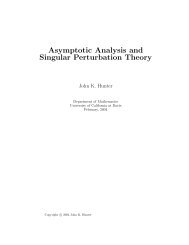Minimization by Random Search - Department of Mathematics
Minimization by Random Search - Department of Mathematics
Minimization by Random Search - Department of Mathematics
You also want an ePaper? Increase the reach of your titles
YUMPU automatically turns print PDFs into web optimized ePapers that Google loves.
MINIMIZATION BY RANDOM SEARCH TECHNIQUES<br />
TABLE 2.<br />
Minimize x * , X= (1,0, . . ., ), Algorithm 2, 20 Runs for each n.<br />
Mean numb. Stand. deviation Standard<br />
Dimension funct. eval. from mean numb. Error<br />
n N (oN (TN/20 O/nV20 N/n<br />
2 62.8 12.61 2.8 1.4 31.4<br />
3 100.3 18.74 4.2 1.4 33.4<br />
5 160.9 25.8 5.8 1.5 32.2<br />
10 348.0 38.0 8.5 0.8 34.8<br />
These last results are similar to those obtained <strong>by</strong> Schrack and Borowski [16]. This<br />
"linearity" was first observed <strong>by</strong> Schumer and Steiglitz [12], the algorithm that they<br />
propose has K ' 80. To explain the linear relation we note, that for large n and with<br />
optimal choice for the step size, the probability p <strong>of</strong> success (i.e., to obtain a decrease<br />
in the value <strong>of</strong> f) is given <strong>by</strong><br />
(1 - p2/4)(n-<br />
1)/2<br />
(n - 1) 2p(7r/2n)'/2<br />
where p is the optimal step size, see [12]. Now the adaptive step size methods,<br />
Algorithm 1 and 2, do not tend to produce the optimal step size p but they tend to<br />
maintain the probability <strong>of</strong> success constant. Since the above relation is valid when the<br />
step size p is small, for a given p we can use it to find p as a function <strong>of</strong> the dimension<br />
n. We start from the assumption that p is <strong>of</strong> the form c/fn (as is the case for the<br />
optimal choice <strong>of</strong> p with c = 1.225), we get<br />
p/2 - (n - 2)p3/48 + (n - 2)(n - 3)p5/640<br />
~p-^~ ~2p( r/2n)I /2<br />
c/2Vn - 2 - (n - 2)c3/48(n<br />
= c [1 - c2/24 + c4(n - 3)/320(n<br />
4 v<br />
- 2)Vn - 2 + (n - 2)(n - 3)c5/640(n - 2)2/n - 2<br />
1/2<br />
2(7r/n - 2 )<br />
- 2)]<br />
which tends to a constant as n goes to + oo. So we see that these adaptive algorithms<br />
tend to fix the step size near Kn-/2. Since the expected decrease in the function value<br />
is p2p [12] we see that the expected step in the direction <strong>of</strong> the solution is cp/n. Now cp<br />
is constant and this would then explain the linear correlation. (This is only a heuristic<br />
justification <strong>of</strong> this linearity result, the argument is weak since the Algorithms 1 and 2<br />
do not necessarily maintain the probability <strong>of</strong> success equal to the same constant for<br />
different dimensions.)<br />
Nonetheless, this correlation coefficient K allows us to compare various random<br />
search techniques at least as far as their effectiveness in obtaining local minima. To<br />
illustrate this point let us compare the performances <strong>of</strong> Gaviano's algorithm [4] and<br />
Algorithm 2 when minimizing x T. x. Gaviano's algorithm proceeds as follows:<br />
STEP 0. Pick x?, set k = 0;<br />
STEP 1. Generate a sample / from a uniform distribution on the unit hypersphere;<br />
STEP 2. Set xk + I= argmin{f(y) Iy =xk + AX, X E R } and return to Step I with<br />
k= k+ 1.<br />
27
















